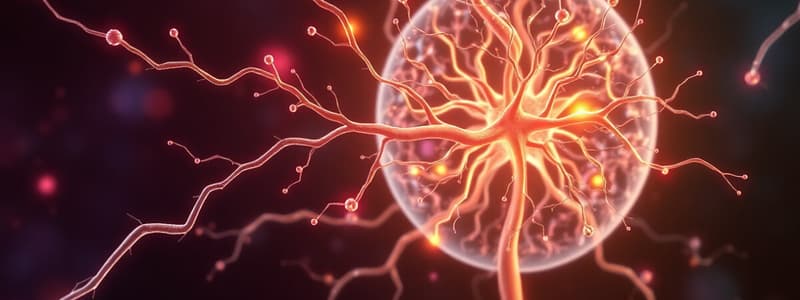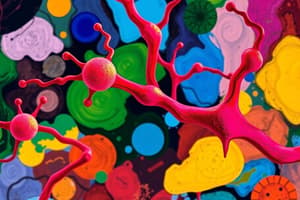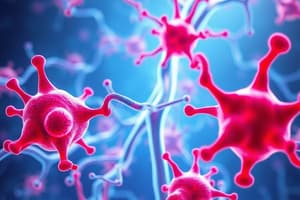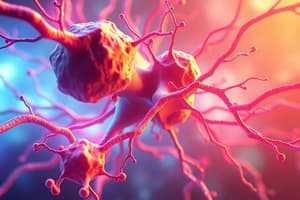Podcast
Questions and Answers
Which of the following adrenergic receptors is primarily responsible for increasing heart rate and aqueous humor production?
Which of the following adrenergic receptors is primarily responsible for increasing heart rate and aqueous humor production?
- β1 (correct)
- α2
- α1
- β2
Norepinephrine is the first line treatment for cardiac arrest due to its significant effect on increasing heart rate?
Norepinephrine is the first line treatment for cardiac arrest due to its significant effect on increasing heart rate?
False (B)
What is the primary mechanism by which tricyclic antidepressants exert their antidepressant effects?
What is the primary mechanism by which tricyclic antidepressants exert their antidepressant effects?
blocking the reuptake of norepinephrine into the presynaptic neuron
The adverse effects of direct adrenergic agents such as adrenaline include hypertension, necrosis due to vasoconstriction at the site of injection, tachycardia, reflex bradycardia and ______.
The adverse effects of direct adrenergic agents such as adrenaline include hypertension, necrosis due to vasoconstriction at the site of injection, tachycardia, reflex bradycardia and ______.
Match the following adrenergic agents with their primary clinical use:
Match the following adrenergic agents with their primary clinical use:
Which of the following is the mechanism of action of indirect antiadrenergic agent dexmedetomidine?
Which of the following is the mechanism of action of indirect antiadrenergic agent dexmedetomidine?
Methyldopa increases vasoconstriction and decreases sedation by promoting the formation of methylnoradrenaline?
Methyldopa increases vasoconstriction and decreases sedation by promoting the formation of methylnoradrenaline?
What is the primary clinical use of phenoxybenzamine, and how does it achieve its therapeutic effect?
What is the primary clinical use of phenoxybenzamine, and how does it achieve its therapeutic effect?
Propranolol, a non-selective β-blocker, uniquely has antihypertensive action via blocking ______ secretion, and also treats conditions like angina, arrhythmias, myocardial infarction, and excessive catecholamine action in hyperthyroidism.
Propranolol, a non-selective β-blocker, uniquely has antihypertensive action via blocking ______ secretion, and also treats conditions like angina, arrhythmias, myocardial infarction, and excessive catecholamine action in hyperthyroidism.
Which of the following antiadrenergic agents is used to treat glaucoma by reducing the secretion of aqueous humor?
Which of the following antiadrenergic agents is used to treat glaucoma by reducing the secretion of aqueous humor?
Which of the following statements accurately describes the mechanism of action of moclobemide?
Which of the following statements accurately describes the mechanism of action of moclobemide?
Pseudoephedrine primarily exerts CNS effects as a nasal decongestant due to its ability to cross the blood-brain barrier effectively?
Pseudoephedrine primarily exerts CNS effects as a nasal decongestant due to its ability to cross the blood-brain barrier effectively?
Describe the two primary mechanisms of action of indirect cholinergic drugs, including specific examples for each mechanism.
Describe the two primary mechanisms of action of indirect cholinergic drugs, including specific examples for each mechanism.
Due to its ability to cross the blood-brain barrier, ______ is used to treat atropine poisoning, exerting both CNS and peripheral effects.
Due to its ability to cross the blood-brain barrier, ______ is used to treat atropine poisoning, exerting both CNS and peripheral effects.
Match the following cholinergic agents with their primary clinical application or characteristic:
Match the following cholinergic agents with their primary clinical application or characteristic:
Which of the following is the primary reason acetylcholine has no clinical uses?
Which of the following is the primary reason acetylcholine has no clinical uses?
Sarin poisoning cannot be effectively treated after 'aging' occurs because aging makes the inhibition reversible.
Sarin poisoning cannot be effectively treated after 'aging' occurs because aging makes the inhibition reversible.
Explain the mechanism by which pralidoxime reverses organophosphate poisoning and why its effectiveness is limited by the 'aging' process.
Explain the mechanism by which pralidoxime reverses organophosphate poisoning and why its effectiveness is limited by the 'aging' process.
The muscarinic receptor subtype responsible for contractions and secretions in the lungs, glands, and GI tract, as well as affecting the central nervous system, is the ______ receptor.
The muscarinic receptor subtype responsible for contractions and secretions in the lungs, glands, and GI tract, as well as affecting the central nervous system, is the ______ receptor.
Varenicline, used for smoking cessation, acts on which type of receptors?
Varenicline, used for smoking cessation, acts on which type of receptors?
Flashcards
Parasympathetic Nervous System
Parasympathetic Nervous System
Part of the autonomic nervous system responsible for 'rest and digest' functions.
Sympathetic Nervous System (SNS)
Sympathetic Nervous System (SNS)
Part of the autonomic nervous system responsible for 'fight or flight' responses.
α1 Adrenergic Receptors
α1 Adrenergic Receptors
Adrenergic receptors that cause vasoconstriction, pupil dilation, and bladder sphincter contraction.
α2 Adrenergic Receptors
α2 Adrenergic Receptors
Signup and view all the flashcards
β1 Adrenergic Receptors
β1 Adrenergic Receptors
Signup and view all the flashcards
β2 Adrenergic Receptors
β2 Adrenergic Receptors
Signup and view all the flashcards
β3 Adrenergic Receptors
β3 Adrenergic Receptors
Signup and view all the flashcards
Adrenaline (Epinephrine)
Adrenaline (Epinephrine)
Signup and view all the flashcards
Norepinephrine (Noradrenaline)
Norepinephrine (Noradrenaline)
Signup and view all the flashcards
Phenylephrine
Phenylephrine
Signup and view all the flashcards
Salbutamol / Terbutaline
Salbutamol / Terbutaline
Signup and view all the flashcards
Moclobemide
Moclobemide
Signup and view all the flashcards
Tricyclic Antidepressants
Tricyclic Antidepressants
Signup and view all the flashcards
Phenoxybenzamine
Phenoxybenzamine
Signup and view all the flashcards
Propranolol
Propranolol
Signup and view all the flashcards
Dexmedetomidine
Dexmedetomidine
Signup and view all the flashcards
Pilocarpine
Pilocarpine
Signup and view all the flashcards
Physostigmine
Physostigmine
Signup and view all the flashcards
Donepezil
Donepezil
Signup and view all the flashcards
Pralidoxime
Pralidoxime
Signup and view all the flashcards
Study Notes
Autonomic Pharmacology
- The autonomic nervous system (ANS) consists of the parasympathetic and sympathetic systems
Parasympathetic System
- Known as the "rest and digest" system
Sympathetic System
- Known as the "fight or flight" system
Adrenergic System
- Adrenergics target the sympathetic nervous system (SNS)
Adrenergic Receptors
- α1 receptors cause vasoconstriction, bladder sphincter contraction, pupil dilation (mydriasis), and are involved in glycogenolysis
- α2 receptors reduce intraocular pressure (IOP) and salivary gland activity
- β1 receptors increase heart rate and aqueous humor production
- β2 receptors cause bronchodilation, increased mucociliary clearance, glycogenolysis (short-term), insulin release (long-term), and uterus relaxation
- β3 receptors relax the bladder detrusor muscle and increase lipolysis
Direct Adrenergic Agents
Non-Selective Adrenergic Agents
- Adrenaline is used for cardiac arrest and anaphylactic shock
- Norepinephrine is used for severe hypotension, increasing blood pressure without significantly raising heart rate
Weird Selective Adrenergic Agents
- Dopamine is used for cardiac arrest and hypotension, and also increases diuresis
Adverse Effects of Adrenergic Agents
- Hypertension
- Necrosis due to excessive vasoconstriction at the injection site
- Tachycardia
- Reflex bradycardia
- Ventricular arrhythmias
α Selective Adrenergic Agents
- Oxymetazoline is used for nasal congestion
- Phenylephrine is used for hypotension and nasal congestion
- Brimonidine is used for open-angle glaucoma and is neuroprotective
β Selective Adrenergic Agents
- Isoprenaline is used for asthma and cardiac arrest
- Dobutamine is used for congestive heart failure
- Salbutamol/Terbutaline are used for asthma and premature labor
- Mirabegron is used for overactive bladder
Indirect Adrenergic Effects
- Neurotransmitters are stored in vesicles, released into the synaptic cleft, taken back up by transporters into the presynaptic neuron, and broken down by MAO
Moclobemide
- A MAOA inhibitor used as an antidepressant
- Prevents the breakdown of norepinephrine, increasing its levels in the synaptic cleft and exerting CNS effects
Tricyclic Antidepressants
- Block the reuptake of norepinephrine into the presynaptic neuron
- This prolongs its presence in the synaptic cleft and exerts CNS effects
Pseudoephedrine
- Used as a nasal decongestant
- Taken into the presynaptic neuron and displaces norepinephrine from vesicles
- This allows norepinephrine to exit the vesicle into the synaptic cleft, increasing its levels
Direct Antiadrenergic Agents
α Selective Antiadrenergic Agents
- Phenoxybenzamine is used in the treatment of pheochromocytoma
- This is a tumor that releases excessive amounts of norepinephrine and adrenaline, causing complications like hypertension
- Phenoxybenzamine binds to α adrenoceptors to produce a temporary blockade
- "axosin"s like prazosin are used for hypertension and urinary symptoms of benign prostatic hyperplasia
β Selective Antiadrenergic Agents
- Propranolol is used for hypertension, angina, arrhythmias, myocardial infarction, and excessive catecholamine action in hyperthyroidism
- Sotalol is used for arrhythmias
- Timolol is used for glaucoma
- Bisoprolol is used for hypertension, angina, and myocardial infarction
- Betaxolol is used for glaucoma
Indirect Antiadrenergic Agents
- Dexmedetomidine is a sedative
- It binds to α2 adrenoceptors in the presynaptic neuron, decreasing norepinephrine release into the synaptic cleft
- This leads to a reduction in vasoconstriction and increased CNS effects like sedation
Methyldopa
- Used for hypertension
- Inhibits tyrosine hydroxylase, leading to the formation of false transmitter methylnoradrenaline instead of norepinephrine
- This reduces vasoconstriction and increases effects such as sedation
- Can cause adverse effects like hemolytic anemia and hepatotoxicity
Cholinergics
- Cholinergics target the parasympathetic nervous system (PNS)
Cholinergic Receptors
- M1 receptors are located in the stomach and CNS
- M2 receptors are located in the heart and CNS
- M3 receptors are located in the lungs, glands, GI tract, and CNS, causing contractions and secretions
- Note: M3 receptors include eccrine sweat glands, which are controlled by the SNS
- M4 and M5 receptors are located in the CNS
- Nm (N1) receptors are located in skeletal muscle
- Nn (N2) receptors are located in the ganglion and CNS
Direct Cholinergic Agents
Non-Selective Cholinergic Agents
- Acetylcholine has no clinical uses as it is broken down by acetylcholinesterase
m Selective Cholinergic Agents
- Pilocarpine is used for glaucoma and dry mouth (xerostomia)
- Bethanechol is used for gastric atony and urinary retention
n Selective Cholinergic Agents
- Nicotine is used to aid smoking cessation
- Varenicline is also used to aid smoking cessation, but may cause psychiatric symptoms
Indirect Cholinergic Drugs
- Act on nicotinic receptors in the postganglionic neuron in the PNS
Physostigmine
- Used for atropine poisoning
- Crosses the blood-brain barrier (BBB) and has both CNS and peripheral effects
Neostigmine
- Used for myasthenia gravis and reversal of non-depolarizing neuromuscular blockade
- Does not cross the BBB and is selective for peripheral effects
Donepezil
- Used for Alzheimer’s disease
- Crosses the BBB readily and is selective for CNS effects
Sarin
- Causes poisoning
- It is an organophosphate and a suicide inhibitor of acetylcholinesterase (AChE)
- Can be treated with pralidoxime, which binds with higher affinity to phosphate in organophosphate and regenerates cholinesterase
- Does not work after "aging" occurs (further chemical changes that make inhibition irreversible)
Studying That Suits You
Use AI to generate personalized quizzes and flashcards to suit your learning preferences.




